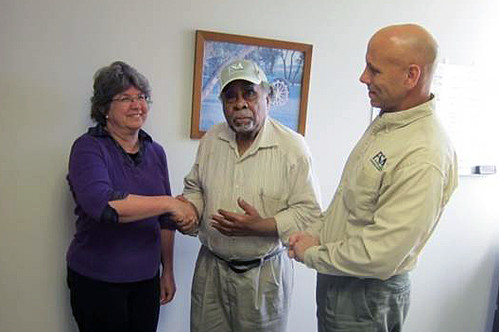
This post is part of a Microloan Success feature series on the USDA blog. Check back every Tuesday and Thursday as we showcase stories and news from USDA’s Farm Service Agency.
For Malachi Duncan, life as a farmer is anything but boring. At age 92, he’s going strong and ready to do more.
“I was out on the tractor trying to locate a cow,” said Duncan, who farms 43 acres of his family’s land in Union, S.C. It’s the same land he used to plow with mules before planting cotton, peanuts and corn.
“Back then, we didn’t have any tractors,” said Duncan. “Now, that was hard with long hours. But we farmed to survive.”
Duncan, a proud farmer for six decades, left the farm during World War II to serve in the U.S. Army in Europe under the command of General George S. Patton. Duncan made his way through France, Germany, Italy and Africa before returning to study economics and history at Benedict College in Columbia, S.C. He went into the teaching profession and became a Baptist minister with Bethel African Methodist Episcopal church.
Today, Duncan is retired from teaching and ministering. He’s farming his land, which includes six cows that roam 40 acres of pasture. His son helps with day-to-day chores.
Last year, when Duncan wanted to buy a bush hog and fertilizer, he talked to Farm Service Agency Loan Officer John McComb about a Microloan. USDA’s Microloan program allows beginning, small and mid-sized farmers to access up to $35,000 in loans using a simplified application process with up to seven years to repay.
“He started farming over 60 years ago when farming as a minority in the Deep South was a tough business,” said McComb, who assisted Duncan through the short loan process. “He’s one of the newest Microloan customers, but he has likely seen more changes to American agriculture than most of our customers.”
Duncan said the microloan provided the small amount needed. “They were wonderful and courteous and explained everything I needed to know and what they expected of me,” he said.
Duncan said he has seen more than just physical changes, but the way of life has changed. From the way people raise their children to the way people farm. “People aren’t as compassionate as they used to be,” said Duncan, who raised four children and has eight grandchildren and, as he puts it, “heaven only knows how many great-grandchildren.”
The advice he gives new farmers today? Education is the key. “Farming is big business now. You have to understand it, expose yourself to it and be involved,” said Duncan. “Go into it because you love it. You will only get out of it what you put into it.”
USDA is proud to see the progress that farmers and ranchers are making in their daily operations with the help of the Microloan program. To date, USDA has issued more than 4,900 Microloans totaling $97 million. The microloan program is part of USDA’s StrikeForce for Rural Growth and Opportunity Initiative, our commitment to growing economies, increasing investments and creating opportunities in poverty-stricken rural communities like Union County, South Carolina and 19 other states.
Visit the FSA website to learn more about our farm loan programs.
